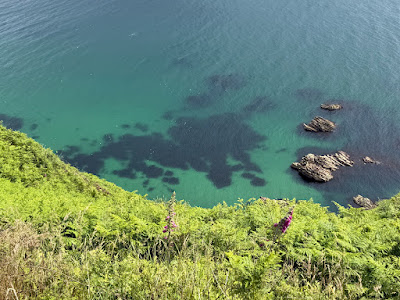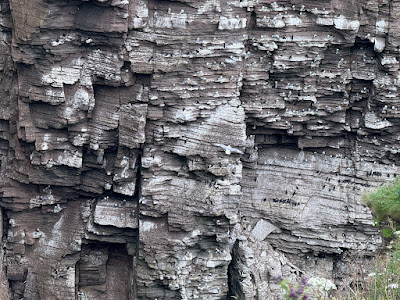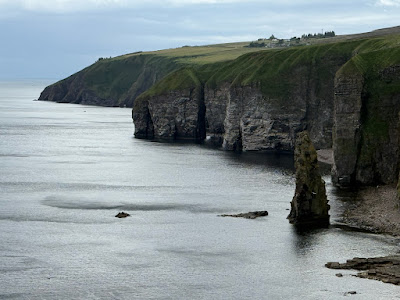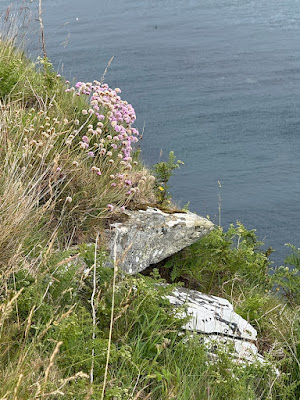If I had to sum up the day it would be:
Guillemots.
Thousands of them.
I’ve never seen anything like it. We thought the colony on the Pembrokeshire Coastal Path last year was amazing. But today was extraordinary.
We agreed to have a slow start as the guidebook indicated 4 hours walking. I realised that my ankles and knees had been stiffening up, and my glut had twinged on the way down into Berriedale harbour. It dawned on me that my insoles had again lasted over 500 miles and it was time to replace them with the new ones in the supply box. This made a difference immediately, but the transformation at the end of the day was remarkable - no stiff and aching joints!
We arrived back at Berriedale just before midday and stopped for coffee and excellent fruit loaf at the River bothy cafe. They wished me well on my walk and we set off at 12:30.
The harbour at Berriedale is one of my favourite places - the hamlet, the sharply curved harbour entrance with the protective promontory cliffs covered by nesting fulmars and kittiwakes, and the very rickety suspension footbridge combine to make it a memorable place.
The path climbed sharply up from the back of the row of old fishermen’s cottages onto the cliffs and undulated regularly for the next hour through freshly cut bracken and grass, making the way forward clear. Early on I noticed guillemots in the water and was delighted when I realised there were a pair of puffins in amongst them - notably smaller but the big give-away were the colourful beaks. I wasn’t sure if there were razorbills as well and resolved to check for ID in the Collins birds app later on.
The going would have been hard without the vegetation cut back, and there were a number of places where the path was very much on the cliff edge. But they made viewing of birds on the cliffs so much easier!
Martin aimed to turn back after an hour but we had wanted to stop for lunch at a good viewpoint. After a number of “let’s just go round the next corner”, Martin put his foot down and said he would go back. As he was turning away I dropped down to a small promontory and realised it overlooked the first sea arches of the section, as well as an impressive waterfall. I called him back with some relief - it would have been such a shame for him to have missed it.
Looking down I realised there were guillemots nesting on the cliffs near the big waterfall and stopped to check if I could see any razorbills. I noted from the app that they are distinctly black compared to the guillemots, with longer tail and very distinctive beak. I couldn’t say I had distinguished any.
I spotted a bench coming up and thought I might have a break but what I then saw stopped me in my tracks. The large sea arch of An Dun had looked notably white when we had lunch and I now realised why. There were literally thousands of guillemots nesting on the cliffs near face - what a racket, but what was almost more overwhelming when I moved downwind was the smell, or should I say stink, of guano. If you’ve smelt the penguin enclosures at zoos and amplify that a hundred times, you’ll get the idea!
But I was entranced. I spent time scanning for possible razorbills and thought it was possible there were a few low down on the cliff but I couldn’t be sure. What I did see was a solitary puffin at a burrow in the grass immediately at the top of the cliff, with fulmar close by. That seemed strange to me, but apparently possible.
I realised I needed to move on or would be late to meet Martin at Dunbeath. Walking on, just before the stack - called the Clet - I noticed a quieter cliff face. It was notably quiet and populated with a number of fulmar, a few guillemot, but to my delight a razorbill identifiable by its distinct bill. A little further on, I could see a couple of razorbill in the water in amongst around 30 guillemots. As with the kittiwake and fulmar yesterday, it was very useful to be able to see both species together and learn how to distinguish them.
Just beyond the Clet, another pair of buzzards circled and mewed and I noticed there were a number of greater black backed gulls here too. I looked down onto the stack and realised there was a large grey seal bobbing in the water.
It was time to move on, and it was at this point the clearing of vegetation stopped, so my plan to increase my pace was well and truly scuppered. With the path clinging to the cliff edge and bending around a number of deep geos, it was important to watch my step so I slowed my pace.
Eventually the route turned uphill away from the cliffs through a carpet of spotted orchids before cutting across a field (no distinct path here at all) before a clear path through woodland led to the old A9 which has now become the drive for Dunbeath castle. Now I was able to up my pace as initially intended! A large, dark bird flew out of the trees in front of me just past castle entrance - a magnificent golden eagle.
As I dropped down towards Dunbeath, I saw Martin sitting on a stone bench and we proceeded down the hill to the harbour and the car. The drive back to Lairg would be 90 minutes. We would be relieved in 2 days when we moved up to Keiss.




















Comments
Post a Comment
Please do leave a comment